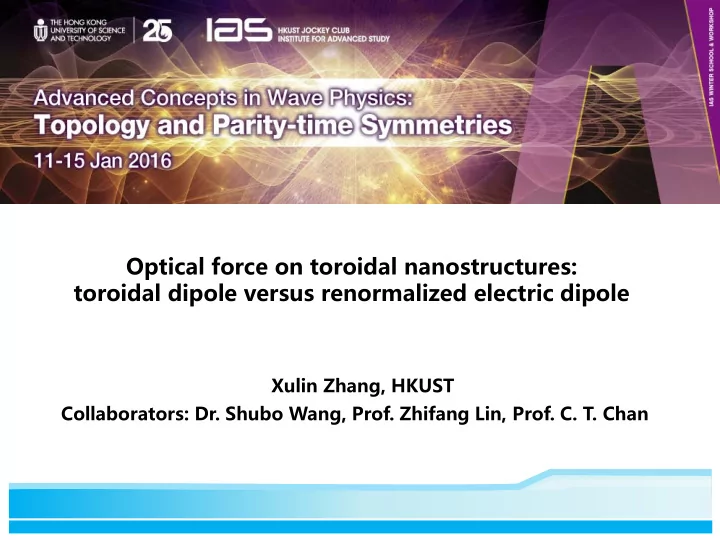

Optical force on toroidal nanostructures: toroidal dipole versus renormalized electric dipole Xulin Zhang, HKUST Collaborators: Dr. Shubo Wang, Prof. Zhifang Lin, Prof. C. T. Chan
Background Multipoles Electric dipole Magnetic dipole Toroidal dipole Experimental demonstration of toroidal dipole Confusion about the toroidal multipoles T. Kaelberer, et al., Science 330 , 1510 (2010)
Background ? Classical textbooks
Multipole definition Source-representation Field-representation renormalized multipoles primitive multipoles ( ) ( ( ) ( ∑ ) ) 1 = + ( ) 3 3 ∫ ∫ ′ ′ ′ ′ = ρ = × E iE a N k , r b M k , r , p r dv , m r J dv , s mn mn mn mn mn i i i i 2 V V n m , ( ) ( ( ) ( k ∑ ) ) 2 ( ) ( ) ( ) ∫ ∫ = + ′ ′ ′ ′ ′ ′ = ρ = × 3 3 e m H E b N k , r a M k , r . q rr dv , q r J r dv , ωµ s mn mn mn mn mn ij i j ij j i 3 V V n m , 0 = irreducible multipoles 1 ( ) ∫ ∫ = ′ ρ ′ = ′ × ′ p r dv , m r J dv , i i i i 2 V V 1 ∫ ′ ′ ′ ′ = − δ ρ ( ) e 2 Q rr r dv , ij i j ij V 3 1 ∫ ′ ′ ′ ′ ′ = × + × ( ) m Q ( r J ) r ( r J ) r dv , ij i j j i 3 V + irreducible dipoles: p, m toroidal multipoles 1 toroidal dipole: t ∫ ′ ′ ′ ′ = ⋅ − 2 t ( r J r ) 2 r J dv , i 10 V i renormalized dipoles: p, m
Two viewpoints of optical forces Optical force Source-representation Field-representation Taylor expansion of vector potential Based on vector spherical functions ( ) ( ( ) ( ( ) ( ) ∑ ) ) ∫ ′ ′ µ π ω = + i R c / 3 3 A r = / (4 ) J r e / R dv E iE a N k , r b M k , r 0 s mn mn mn mn mn V n m , Lorentz force Variation of Maxwell stress tensor πε ( ) ( ) 2 ∑ 1 1 = 2 ∗ + ∗ = ∇ ∗ ⋅ = ∇ ∗ ⋅ p p m 0 F E Re g a p l q a F Re E p F Re B m + 0 , , 1 , , z mn m n m n mn m n m n i i 2 k 2 2 = ( ) n 1, m k πε = − ∇ ∗ ⋅ t 2 F Im E t ∑ ∗ ∗ = 2 + m 0 i F E Re g b q l p b 2 c + z 0 mn m,n m,n 1 mn m,n m,n 2 k 4 5 k k = n 1 ,m ∗ ∗ = − × × πε int ( ) F Re p m + Im m t 4 ∑ ∗ πε πε = − 2 2 int 0 12 c 12 c F E Re l a b 0 0 z 0 mn m n , m n , 2 k = n 1, m
Optical force on single helix Magnetic dipole Source-representation Field-representation The effect from the toroidal dipole is completely masked by the irreducible electric and magnetic dipoles, obscuring any distinction between the irreducible and the renormalized dipoles, as in most conventional structures.
Optical force on toroidal nanostructures Source-representation The toroidal dipole is How to explain the necessary for the resonant force in description of optical the field- forces in the source- representation ? representation.
Optical force on toroidal nanostructures The force contribution of toroidal dipole is Field-representation replaced by a renormalized electric dipole. Relationship of the multipoles between source-representation and field-representation + ≈ ≈ p t p m m F F F , F F ik + ≈ ≈ p t p , m m + ≈ ≈ p t p m m C C C , C C c sca sca sca sca sca Electric radiation field: (source representation)
Detection of toroidal resonance Detection of the toroidal resonance Source-representation ω 4 Z = 2 p 0 p C sca πε 2 3 3 c E 0 0 ω 2 4 Z ik + = + p t 0 C p t sca πε 2 3 c 3 c E 0 0 Field-representation ( ) π 6 = 2 2 2 p C A + A + A sca e 11 o 11 e 01 2 k ( ) π 6 = 2 2 2 m C B + B + B sca e 11 o 11 e 01 2 k Scattering cross section The total number of photons scattered The number of photons scattered as well as their Optical force distributions
Some other demonstrations SRR structures
Summary Some confusions in the understanding of various multipoles have been clarified by introducing and distinguishing the primitive multipoles, irreducible multipoles, and renormalized multipoles. The toroidal dipole is meaningful and necessary in the source representation while its contribution can be completely incorporated into the renormalized electric dipole in the far field. We also show that optical force enables the observation of the toroidal response of a nanostructure even when its effect on scattering power is overwhelmed by the conventional multipoles. Phys. Rev. A 92, 043804 (2015)
Thanks for your attention!
Recommend
More recommend